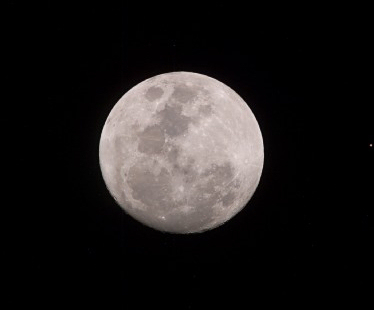

The moon rising over the Chihuahuan Desert changes from a warm-appearing orange to a cold silver-white. Appearances, of course, can be deceiving. The color changes as the moon rises are due to our atmosphere, not conditions on the moon itself.
So what is the moon like? First, keep in mind that we see only one face
of the moon, since it rotates one time for every revolution it makes around the earth.
Secondly, we need to understand that the moon has no atmosphere. As a result, the moon
lacks the buffering effect of earth's atmosphere, and temperatures fluctuate wildly
between sunlight and shadow. At the moon's equator, the temperature varies from
nearly minus 300° Fahrenheit during its night to plus 212° when sunlit. This
being the case, recent measurements have elicited interest. Several areas high on
crater walls near the moon's north pole appear to be in perpetual sunlight, giving
a temperature range estimated between minus 40 and minus 86°—not quite
Chihuahuan Desert summer temperatures, but they sure beat 300° below zero!

Contributor: Arthur H. Harris, Laboratory for Environmental Biology, Centennial Museum, University of Texas at El Paso.
Desert Diary is a joint production of the Centennial Museum and KTEP National Public Radio at the University of Texas at El Paso.

Photograph of the moon, courtesy of NASA.
Bussey, D. B. J., K. E. Fristad, P. M. Schenk, M. S. Robinson, and P. D. Spudis. 2005. Constant illumination at the lunar north pole. Nature 434:842.